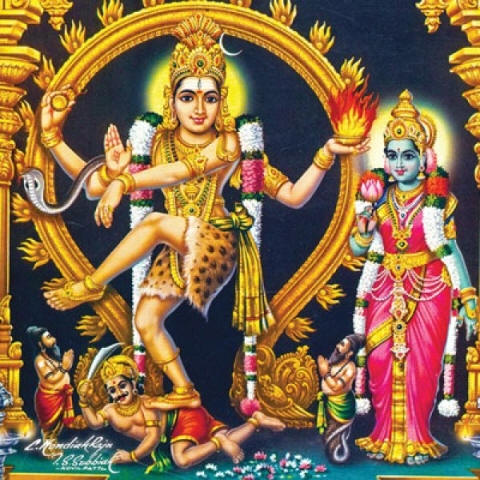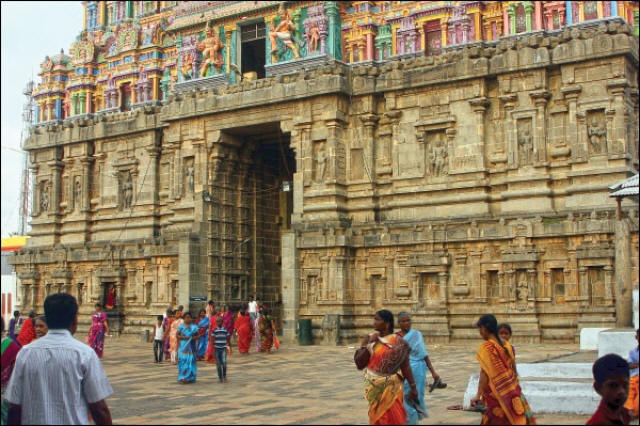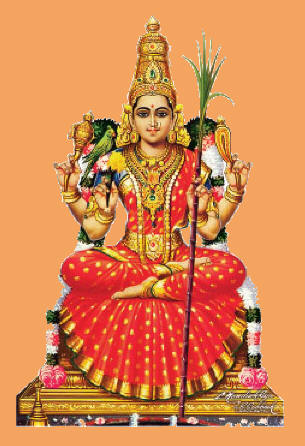GMS = Give Me Sakthi
Published:17 Jun 2019 8 PMUpdated:17 Jun 2019 8 PM Sakthi Vikatan
சக்தி கொடு! - 6. Give Me Sakthi - 6
Vikatan Correspondent
வி.ஆர்.சுந்தரி Authoress: V. R. Sundari
அம்பலப்புளியில் ஆடல்வல்லான்! The Accomplished Dancer in Ambalapuli

2. Facing these adverse circumstances, a knot of servitors carried the idol in a box and went out of the town.
2. The devotees reached a tamarind grove in the dead of night. They found a hollow in a tamarind tree, ensconced the idol in it, and returned home.
3. The owner of the tamarind grove happened to notice the plugging of the hole in the tree. He was curious and suspicious and so peaked into the hollow just by moving the plug a little bit. He saw a beautiful divine form looking at him softly. He was ecstatic, seeing the divine sight.
4. He placed the plug back in its place and came back home. He announced casually to the villagers he dreamt of Tamarind-tree Swamy. He offered daily worship to the Swamy without revealing it to anyone.
5. Years rolled. The invasion fear abated. The knot of servitors came back to retrieve the idol but forgot where precisely the tamarind tree was. Unable to find the Swamy, they were standing confused. Nearby an elderly man asked his nearby minion, “Take the herd to the Ambala-p-puḷi (The Tamarind tree of the village headman). I will follow you.”
6. The servitors, hearing this, asked the older man the reason for naming the tree, Ambala-p-p uḷi? The elderly man answered, “I have no idea. My employer does worship very often at the foot of the tree. You have to ask him.” The servitors went to the owner of the grove and posed the question. The owner told the truth to the servitors. They were happy. With the farmer’s consent, the servitors removed the idol from the hollow of the tree and offered worship.
7. The icon ensconced in the hollow of the tamarind tree was no other than the famous Natarajar, the Lord of Dance. The servitors were the Thillaivāz Brāhmaṇas (the hereditary resident priests living in Thillai or Chidambaram). The small town with the Ambala-p-puḷi, the tamarind tree, earned the name ‘Puḷiyaṅkudi.’ The family of the owner of the tamarind grove goes by the moniker, ‘Puḷiyaṅkudiyār.’
8. Tamil Grandpa U.V.S in Ambalap Puḷi, Mahavidvan in Chidambaram, and S. Dhandayuthapani Desikar memorialized this piece of history.
9. There are many endowed with grace who knew the greatness of the Chidambaram temple and explained its greatness. Let us enjoy some of their expositions. Before that, we will learn about the prevalent sacerdotal and ceremonial services in the Chidambaram Temple.
10. At about 6 a.m. in the Chidambaram Temple, the priests offer Naivēttiyam such as milk and fruits, to the holy feet of Swamy in his bedchamber. They place the holy feet on a palanquin and bring them to the Dance Hall, as is customary. This early morning service is called Pāl Naivēttiyam (milk offering).

12. Sacerdotal services take place at junctional times: 9 a.m.; 11 a.m.; and noon.
13. The second and the 11 a.m. service, ritual ablution of crystal Liṅgam takes place. Later ablution of Ratna Sabāpathy takes place, with waving of camphor lights in the front and the back of the Swami. At this time, a great multitude of servitors obtains the Darśan of Swami.
14. After 5 p.m. Spatika Liṅgam Abhiṣēkam, the 6 p.m. evening service takes place. Seven p.m. Spatika Liṅgam ritual ablution (Abhiṣēkam) at 7 p.m. precedes the 7:30 p.m. Chidambara Rahasya service.
15. Eight p.m. service, 9:30 p.m. service to Spatika Liṅgam (Crystal Liṅgam) and the midnight service at 10 p.m. take place.
16. At 10 p.m., the arts of all the deities at all temples come to rest in Lord Natarājar in Thillai, as said and sung by Appar Swāmigaḷ. The Ardha Jāma (midnight) services in Chidambaram are special.
17. After waving of the lights during midnight services, the holy feet of Perumāṉ of The Hall of Consciousness are placed on a palanquin for circumambulation and later placement in the bedchamber. As a continuation, the waving of lights service takes place. Then, waving of lights for Chandikēsuvarar and Bhairavar takes place, followed by the same service to ‘Ardhajāma Azakar,’ as the last Pūja.
18. We have witnessed the six times a day Pūjais and let us keep in memory the six kinds of ablutions offered to the Lord of Dance year after year.
More to come.
Rain of Gold
1. Poṉmazai peithūr village is about 3 km from Kāñchipuram. A fascinating sacred story is behind this name.
2. Once upon a time, king Ākāsa Bhūpathi ruled this part of the nation. He had Piḷḷaiyār himself born as his daughter, say the Purāṇās. On an auspicious good day, the ceremonial naming festival took place. Besides, Sumaṅgali Bhōjaṉam (Coverture feast) went well.

3. Śrī Kāñchi Kāmātchi Ammaṉ, the Mother of the world, came to eat the festival dinner. Ambikai (Ammaṉ) made sure it rained for a Mukūrtham (1 ½ hour): an auspicious event.
4. Along with the rain, gold coins poured down from the heavens. Witnessing this wonderful event, the king and his subjects were joyous.
5. Mūka Kavi sang this event in the poem, ‘Pañcha sathī.’
- Sailapathi